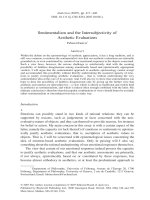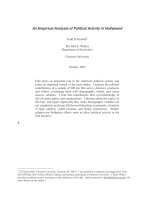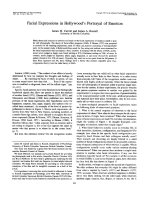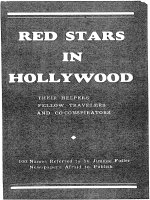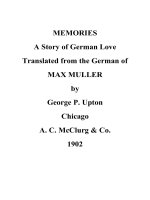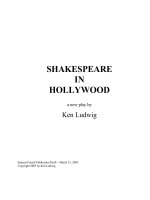Images of Power in Hollywood Films: The Example of Star Wars ppt
Bạn đang xem bản rút gọn của tài liệu. Xem và tải ngay bản đầy đủ của tài liệu tại đây (582.1 KB, 14 trang )
Images of Power in Hollywood Films:
The Example of Star Wars
Jeffrey A. Hart
Department of Political Science
Indiana University
Woodburn Hall 210
Bloomington, IN 47405
Tel (812) 855-9002
Email:
Web: />Paper prepared for delivery at a conference on The Image of Power in Literature, Media,
and Society, sponsored by the Society for the Interdisciplinary Study of Social Imagery
and Colorado State University, Pueblo, to be held at Colorado Springs, Colorado, March
9-11, 2006. Please do not cite or quote without the written permission of the author.
Abstract: Feature-length motion pictures distributed by Hollywood studios frequently
deal with issues of power, although sometimes indirectly and often only as a sideline to
the main story. Science fiction and fantasy films in particular are frequently vehicles for
telling stories about power and the abuse of power. In this paper, I focus on images of
power in the Star Wars series and examine them in comparison with other ways of
portraying power in Hollywood films. Tyranny (evil) vs. democracy (good) is the
unifying theme in Star Wars, whereas in other Hollywood films we find different images
of power. For example, images of power based on class are more likely to be found in
movies of the 1930s than now. In the 1950s, we began to see films that portrayed large
private corporations as holders of great power, in some cases greater than that held by
governments. Is there a general trend or tendency in Hollywood's power imagery?
Power
Power has been defined in a variety of different ways by sociologists and political
scientists so it behooves us to review those definitions before launching into an
exploration of the imagery of power. The simplest definition of power is an ability to get
others to do something that they would not otherwise have done. This is sometimes
referred to as power as “capabilities” or “potential” power and is measured in terms of
the attributes of the social actor that allegedly possesses it. An individual is powerful if
she is rich, well-educated, a member of a social elite, etc. A country is powerful if it is
big in population and has a well equipped army, a rich economy, a large territory, or
access to valuable resources. The power as capabilities approach assumes that
capabilities (potential power) can be converted into actual power in some predictable
manner.
1
A second way to define power is in terms of a relationship in which one actor is
observed to attempt to influence another directly and succeeds. This is sometimes called
“actualized” power. The attempt to influence results from differing preferences over
outcomes, and the attempt is successful if the attempt of actor A to influence actor B
results in an outcome preferred by A. A may convince B that A’s preferred outcome is
also B’s preferred outcome without the threat of force by engaging in persuasive
discourse, but if A threatens B with force to get B to act against B’s preferences then we
are talking about “coercion.” Thus, power can be persuasive or coercive.
A third way to define power is in terms of the ability to structure an environment
of choice, to determine the “rules of the game” of some sphere of human activity. Also
called structural power, this notion focuses on how individuals or groups of individuals
influence “regimes” –sets of rules, norms, procedures, and institutions in a particular
area. An example of structural power would be the ability of the Motion Picture
Association to prevent government censorship of movies by adopting a variety of self-
regulatory measures (such as voluntary ratings schemes).
Power is related to a set of concepts which may be represented by images. We
have already spoken about noncoercive forms of power, influence and persuasion, and
one can imagine various ways of graphically representing those noncoercive activiities.
Power that has been institutionalized in the form of institutions is often represented in
terms of the buildings housing those institutions or symbols of the institution or the
functions it performs. Thus, a picture of the Supreme Court building could be used to
represent the institution and an image of a blindfolded woman in a toga holding a balance
might represent the justice dispensed by that court. Some forms of power are more
legitimate than others. Power bestowed upon state institutions under the rule of law and
subject to democratic checks and balances tends to be considered more legitimate than
power obtained by an individual through threats of violence (assuming the individual is
not claiming to act on behalf of the democratic state and under the rule of law). One
would expect therefore that the imagery of illegitimate coercive power would be quite
different from the imagery of legitimate power and authority.
The Imagery of Power vs. the Power of Imagery
It is hard to see how images could be used to coerce people or other social actors,
so we are mostly in the realm of persuasion when we talk about the power of imagery.
However, the imagery of power, in contrast, may include graphic or abstract depictions of
power and related concepts, particularly coercive military power such as in the paintings
of warships or the representation of cannon fire by kettle drums in musical compositions.
Images of international power are also likely to include depictions of armies and military
might. Map or globes are sometimes used, as in the hilarious scene of Adenoid Hinkel
(played by Charlie Chaplin) in The Great Dictator. As wars and war-fighting have
become less a focus of great power politics, especially in the wake of the two World
Wars and the development of nuclear weapons, power imagery increasingly includes
2
non-military symbols of power. An example would be the attack on the World Trade
towers by Al Queda as a symbol of American economic power.
The questions we ask when we analyze the power of imagery tend to focus on
how images affect the viewer. In advertising, for example, one uses attractive images to
persuade the viewer that there is something about the product that is desirable (Inglis
1972). The images do not have to be of the product itself but something else that the
advertiser wants to associate with the product (e.g., the Marlboro man or Tony the Tiger).
The images used in advertising are rarely the same as the images used to portray political
power, however, unless we are talking about political ads. As we will see below,
political ads use many of the same types of imagery that are used to depict power and
power politics in other media.
An Abbreviated History of Power Imagery
Besides military themes, power imagery often focuses on representing various
aspects of government and often includes important legitimating symbols of a specific
political system. Thus the power
imagery of the Roman empire included
portraits of the emperors (on statuary
and on coins, for example) and
symbols of the Empire like the eagle.
But other symbols of the empire, such
as imperial staffs, the wolf who raised
Romulus and Remus, canopies of
heaven, and so forth were used to
underline the power and legitimacy of
the empire. Echoes of this can be seen in the paintings of the Napoleonic era, where
Napoleon himself is portrayed in the guise of a Roman emperor and surrounded by
symbols of his imperial state.
In non-Western civilizations, different symbols of power arose from distinctive
cultures. In the Meso-American world, for example, the jaguar and other felines were
often used as symbols of power (Saunders 1998). In ancient Egypt, besides images of the
Pharaoh, the pyramids (pharaonic tombs) and obelisks, the ankh symbol (representing the
sun god), and sculptured images of the gods represented both religious and secular
power. In China, the dragon represented the might of the emperor. In Japan, each feudal
clan had its own logo-like symbol, just as in the West similar icons were used on battle
flags and on armor to represent feudal claims to power via military prowess.
The contrast between good and evil, especially in government, but also in
religion, became a theme in the power imagery of the middle ages, often in association
with images that portrayed the differences between the Roman Catholic Church its
predecessors. The images of beautiful gothic architecture are juxtoposed with images of
crooked or damaged buildings of the pre-Christian era. Christ is contrasted with the
Roman Coin: Front and Back
3
Anti-Christ and other false prophets. In the many depictions of the last judgment, the
blessed are contrasted with the damned. The recognition that even the agents of the
Church could be corrupt was evidenced in the inclusion of priests, monks and nuns in the
numbers of the damned. These types of contrasting images were secularized in paintings
and frescoes depicting good and bad government in the Renaissance.
Portraits of royalty and nobility emphasized qualities that were supposed to
differentiate them from the masses, not just in terms of their wealth but in terms of
inherited attributes. The portraits of generations of great warriors, churchmen, scholars,
artists of noble families were arrayed on the walls of their country houses as a proof of
their superior breeding. By the eighteenth century, they began to include images of their
estates and the houses themselves on those same walls. In the age of the absolute
monarchies, royal power imagery tended to focus on legitimation of monarchs, frequently
in terms of conquest and empire, but also in terms of the older claims of divine rights via
divine intervention.
The images of power of the time included both Christian and pagan imagery.
Royalty and nobility favored images that underlined their piety and adherence to
Christian beliefs, but strangely combined them with images of Greek and Roman gods
and bacchic pursuits of pleasure. The latter tended to be reserved for private spaces, the
former for public ones.
In the nineteenth and twentieth centuries, the imagery of power shifted to reflect
changes in how power was legitimized. After the American and French revolutions,
there was a marked decline in the use of religious symbols to
legitimate power. In America, the founding fathers and the
Constitution became legitimizing symbols of the regime,
while in France the Revolution itself produced images that
were used by Napoleon and his successors to legitimate their
regimes. In Britain, the church and the monarchy continued
to figure prominently in power imagery but began to be
displaced somewhat by images of empire, industry, and
science as the industrial revolution took hold and the British
Empire and economy grew. This use of industrial images as
a type of power imagery spread with the growth of industrial
competition to Britain in countries such as Germany and the
United States in the late 19
th
century.
Hitler, Mussolini, and Stalin invented power
imageries that were consistent with their efforts to legitimate
authoritarian regimes. They drew upon a set of party-specific and national symbols that
they hoped would attract new followers and neutralize opponents. Militarism was a
common element in all three regimes, as was leader worship, invocations of social
solidarity, along with a hefty dose of racism. The Nazis and the Fascists revived a lot of
imperial symbolism from Roman times. Like the Romans, they favored larger than life
images of the dictators themselves in all media as symbols of power. Like the Romans,
Napoleon, the Emperor
4
they used huge stadiums to stage political rallies, sporting events, and pro-regime
demonstrations, often with a great deal of pomp and pageantry.
“Triumph of the Will,” a documentary film of the Nuremberg rally of directed by
Leni Riefenstahl in 1935, is still considered to be one of the finest examples of film as
propaganda. In this film, you can see many of the elements that will be used later by
George Lucas in his portrayal of the evil Galactic Empire:
triumphal descent of the leader to earth from the clouds
huge mobs of cheering and saluting bystanders
long processionals with singing, banners waving, and colorful pageants
large numbers of soldiers marching in unison
The Swastika, however, predated the Romans. The name
itself is a Sanskrit word and the symbol has been used by a variety
of cultures for about three thousand years. For Hitler, the Swastika
symbolized “the struggle for the victory of the Aryan man…” (Mein
Kampf, pp. 496-497). The colors of the Nazi flag were red, black,
and white. The black swastika was set in the middle of a white
circle upon in a red field symbolizing the National Socialist political movement (Mein
Kampf, ibid.). We will see later that the colors of the Galactic Empire in Star Wars are
also red, black, and white.
Power Imagery in Films
The invention of motion pictures made possible new forms of power imagery. An
example would be a moving image of a waving flag. Initially, many people thought that
the ability to represent realistic moving images was the key distinguishing feature of film
as an art form. Audiences were drawn to short films showing railroad trains, horseback
riders, city traffic, and so forth. Once the novelty of realistic moving images wore off,
however, even short films were used to tell stories. The short films of the Georges
Méliès, distributed by Louis and Auguste Lumière, used special effects to depict fantasies
such as “A Trip to the Moon” (1902) and “Jupiter’s Thunderbolts” (1904).
When the feature film made its debut after the turn of the century, narrative films
that depended on stage plays, operas, or novels for their content began to include power
imagery inherited from those media. The costume dramas in particular represented kings
and queens and their royal courts just as they had been represented on the stage. Silent
films of the 1920s represented pirates and swash-buckling defenders of the realm like the
Three Musketeers. Sword fights continued to please audiences long after swords had
been displaced by firearms on the battlefields.
Whereas the newsclips shown in theaters continued to focus on events involving
heads of state, wars, disasters, and the doings of the rich and famous, feature films and
later newsclips began also to include the activities of everyday people and reflected their
The Nazi Flag
5
concerns. Films based on competitive sports, in particular, appealed to the masses in
ways that costume dramas could not. Part of this shift in content was the result of the
growth in the size of the movie audiences, but other media that prided themselves on
realism – newspapers and magazines, realistic novels and plays – also had moved away
from a focus on elites to a broader representation of society.
This democratizing trend may have been one of the reasons that Walter Benjamin
was optimistic about the revolutionary potential of the arts of “mechanical reproduction.”
In contrast with other more central members of the Frankfurt School such as Theodor
Adorno, Benjamin believed that photography, film, and sound recording could not be
harnessed by conservative forces. Adorno argued instead that these media would all be
used by the capitalist classes to bolster capitalism because capitalists controlled the
culture industries. The main point of agreement between Benjamin and Adorno was that
popular culture was an important part of the class struggle that required serious analysis.
Power Imagery in Hollywood Films
After the establishment of the major motion picture studios in Hollywood in the
1920s, the management of the motion picture industry was dominated by immigrants,
mainly Jews, from Central Europe. These individuals were not secure in their positions
in the America of the first half of the twentieth century. Neil Gabler has argued that the
heads of the studios constructed an image of America in their films that was amenable to
their assimilation into American society, an America of the melting pot. Gabler cites
evidence for this in a variety of themes popularized by Hollywood films of the time:
the condemnation of vigilante “justice”
the exposure of ethnocentrism and racism in all its forms
the successful mixing of people of different races and creeds in the
military (especially in films about World War II)
the positive depiction of African-Americans and African-American music
The avoidance of direct statements against the Nazis and anti-semitism until the 1950s
and failure to confront McCarthyism were cited as evidence of the moguls’ insecurity
regarding their in American society (Gabler 1989).
One debate in the literature on Hollywood films concerns the question of whether
Hollywood is a conservative or radical force. Gabler clearly argues for its conservative
tendencies, although with an idealistic view that America might become a more tolerant
and multicultural nation. Michael Ryan and Douglas Kellner take the perspective of
marxist thinkers like Theodor Adorno and argue that Hollywood films serve to legitimate
the dominant institutions and values of the capitalist system (Ryan and Kellner 1988),
while other scholars, such as Ian Scott, have argued that Hollywood occasionally deviates
from that line to produce subversive films or at least films that go against the mainstream
for a time (Scott 2000).
6
Hollywood films use American symbols like the Stars and Stripes, the Statue of
Liberty, the Capitol
Building, the Lincoln
Memorial, or the White
House (Scott 2000, 7-8). An
example of this is the scene
in “Mr. Smith Goes to
Washington” (1939) when
Jimmy Stewart ‘s character,
Jefferson Smith, revisits the
Lincoln Memorial after a
series of defeats and
disappointments and walks
away with a spirit of
rededication to his cause of
establishing a national boys’
camp. Similarly, in “The
American President” (1995), the White House provides the setting for almost the entire
story and symbolizes the power of the Presidency.
Power Imagery in Films of the Cold War Era
During the Cold War, power imagery in Hollywood films began to reflect the new
status of the United States as a nuclear superpower. Hollywood films did not directly
confront this change of status until after the path had been broken by fringe films like
“Dr. Strangelove” (1964). But there are hints of what was to come with films noir like
“Kiss Me Deadly” (1955) and science fiction films like “The Day the Earth Stood Still”
(1951). In “Kiss Me Deadly,” a box containing radioactive material stolen from the
Manhattan Project provides what Alfred Hitchcock called the “McGuffin” for the plot.
When the box is opened by a female killer near the end of the film, the result is both a
horrifying death for the woman and an explosion that levels a beachfront villa in Malibu.
“The Day the Earth Stood Still” revolves around the efforts of “friendly” aliens to force
the Earth’s people to cooperate with one another to prevent Earth’s destruction. U.S.
government officials react to the aliens by accusing them of being agents of the Soviet
Union, but eventually the scientists and the United Nations save the day.
“Dr. Strangelove” is the first film to use images of B-52s and mushroom clouds to
highlight the potential dangers presented by the nuclear arms race. Earlier Hollywood
films had used images of bombers in support of the building up of the air force. Stanley
Kubrick used these images and others to signal the continuity in militaristic values from
World War II to the Cold War in order to express the problematic nature of that
continuity.
Nothing comes close to “Dr. Strangelove” even today in highlighting the dangers
inherent in the nuclear arms race and the dark motives behind the building of weapons of
The Statue of Lincoln in the Lincoln Memorial
7
mass destruction. Dr. Strangelove himself is a former Nazi scientist now in charge of
dreaming up new weapons. Some have criticized the film for its use of humor, in this
case a rather dark shade of black, but the film succeeds in spite of its flippant tone. The
subject matter stays with you long after you stop laughing, and if you were paying
attention you have to ask yourself why you were cheering for Colonel King Kong (played
by Chill Wills) to succeed in dislodging the nuclear warhead from the B-52’s damaged
bomb bay.
Power Imagery in Star Wars
The six episodes of the Star Wars
series of films contain many types of power
imagery. I would like to discuss them
separately first and then talk about the way
they work together in the underlying story
that unifies the series.
First, and most obvious, there is
power imagery in Star Wars that reflects that
of the Cold War. It is an imagery of good
versus evil. The main examples of this
concern the construction of the first and
second “Death Stars” – large spherical space
stations containing gigantic laser beams that
when focused on a planet result in total
destruction. The evil Galactic Empire is responsible for building these weapons, of
course, and the Rebels are responsible for destroying them (although not before their
awesome power is used to destroy the unfortunate planet of Alderaan). The Death Stars
are clearly analogs to the nuclear weapons arsenals of the superpowers during the Cold
War. Interestingly, it reverses the historical sequence (from democratic republic to
autocratic empire) of the building and deploying nuclear weapons.
The two main political institutions of the Republic are the Senate and the Jedi
Council. The Senate building is a rotunda containing flying round platforms set into
niches in its interior walls that permit the Senators to float into the middle of the interior
when they wish to address the chamber. Each planet is represented by an elected
Senator.
First Death Star Under Construction
8
Senate Exterior Senate Interior
The Jedi perform a combination of services for the Republic besides battling the
Sith. They do simple policing, serve as negotiators when there is a dispute between
planetary and Galactic authorities, and collect intelligence on actual or potential
evildoers. The Jedi have their own building called the Jedi Temple not too far from the
Senate on Coruscant. The Council meets there, but it is also the place where the children
who are taken from their parents at an early age because of high levels of “mitichlorians”
in their blood receive their training. The Jedi report to the Chancellor, the head of the
Galactic Senate, but have their own internal council to make major decisions.
The independence of the Jedi council becomes particularly problematic after the
Senate comes under the control of the Sith Lord, Darth Sidious (who masquerades as
Senator Palpatine, the elected representative of the Planet of Naboo). In Episode III,
Palpatine persuades Anakin Skywalker to support the Senate against the Jedi Council,
which he claims has decided to overthrow the Senate and rule the Galaxy in its stead. In
the course of supporting Palpatine, Anakin loses his way, embraces the dark side and
becomes Darth Vader.
At a less macro level, the power of the two groups that harness “the Force” to
become the most important warriors – that is the Jedi (who fight to defend the Galactic
Republic) and the Sith (who fight to rule the galaxy under the Galactic Empire) – is
represented in a variety of ways but most obviously in their possession and use of “light
sabers.” Light sabers are sword-like weapons with laser cutting capabilities that can be
used against flesh or machinery that comes within reach of the weapon. They also wear
clothing that reflects their status as warriors. The Jedi wear monk-like cloaks over
samurai-like garments. The Sith also wear cloaks but seem to have a bit more freedom in
clothing style and makeup. One easily observable difference is that the Sith’s light sabers
are red, while those of the Jedi are blue or green. Another is that the eyes of the Sith turn
red when they are doing battle. Jedi masters can move objects telekinetically, while Sith
lords can shoot blue lightning bolts from their fingertips. Both try to keep a low profile
and blend in when out in public.
Jedi knights are recruited as children after their blood is tested for the presence of
“mitichlorians.” A mitichlorian is an alien microorganism that lives symbiotically in the
blood of a host being and gives that being special abilities, including the ability to use
“The Force” which is a source of power. According to Jonathan Young,
9
The Jedi describe the force as an energy field that sustains all living things.
An individual may sense the force as intuition, or something spiritual. It is
something beyond individual skill or wisdom. Whether I say I trust my inner
voice or use more traditional language, like trusting the Holy Spirit, somehow
I am listening for something beyond my own calculations. I'm trying to tune
into a larger field of energy and knowledge. When a Jedi advises the hero to
trust the force, he is saying that we must not put all our trust in what we can
know clearly. There are mysteries and powers that are larger than our
knowing and seeing.
1
A child candidate for Jedi knighthood is taken away from his/her parents at a very
young age to receive training at the Jedi Temple. Jedi trainees are instructed in both
spiritual matters and martial arts. The martial arts training involves learning to use the
Force to, for example, fight well with a light saber. The spiritual training is a bit vague,
but seems to focus mainly on learning patience, selflessnesss, etc. – essentially Buddhist
values. The Jedi are not permitted to live with family or to form permanent attachments
of any sort so as to be ready at all times to sacrifice for the greater good. This becomes
an important plot element as the story of Anakin Skywalker unfolds.
Good (The Force) vs. Evil (The Dark Side)
There is a clear opposition of good vs. evil in the Star Wars films. The Jedi are
good, the Sith are evil. The Sith have embraced the dark side while the Jedi resist its
temptations. The Sith are more powerful fighters than the Jedi as individuals but tends to
engage in rather counterproductive leadership skills. Darth Vader, for example, not
unlike Saddam Hussein, kills off his generals one by one by asphyxiating them (without
actually touching them). The Sith rule through intimidation and subterfuge in what is
clearly a totalitarian dictatorship, whereas the Jedi are committed to upholding the
1
Jonathan Young, “Star Wars as Personal Mythology,” />Darth Vader (Sith Lord) Yoda (Jedi Master)
10
principles of Galactic democracy. In this sense the battle between the Jedi and the Sith is
modelled on the Cold War, but interestingly also fits the Bush administration’s vision of
good vs. evil in the post-Cold-War era.
The end of the Galactic Republic and the beginning of the Galactic Empire reads
very much like the story of the fall of the Weimar Republic. Disorder and civil war and
the endless fighting associated with it creates demand for a concentration of power in the
person of the Chancellor and a reduction in the power of the Senate. The Chancellor
proceeds to disband the Senate and rule by fiat. Shades of Hitler. The Jedi are part of a
general rebellion against the Empire that begins in Episode IV (which is actually the first
Star Wars film released) and finally succeeds in Episode VI.
More Nazi imagery is used in characterizing the evil Empire. Darth Vader’s
helmet strongly resembles a Nazi battle helmet (although black and shiny), the uniforms
of his generals are the same shade of gray seen in SS uniforms, the general color scheme
of the Empire emphasizes black, red, and white (just like the Nazi flag).
The Emperor, Darth Vader, and Troopers Darth Maul
Darth Maul, the Sith apprentice of Darth Sidious, not only uses diabolic makeup
which is consistent with the Empire color scheme, he actually has horns on his head.
Star Wars Mythology and the Myth of Lucas
The creator of the series, George Lukas, has become something of a mythical
entity unto himself. It is no secret that Lucas was strongly influenced by the writing of
Joseph Campbell on heroic myths. Campbell himself was influenced by the work of Carl
Jung on archetypes. Lucas admitted that he watched a television series produced by Bill
Moyers for PBS called “The Power of Myth” that featured ideas in Campbell’s The Hero
11
with a Thousand Faces (1949).
2
As a result, there are strong correspondences between
the model of heroic quest in Campbell’s work and the histories of Lucas’ heroes,
particularly Luke and Anakin Skywalker. Whereas Luke measured up to his heroic
potential, Anakin fell short when he embraced the dark side, but of course Anakin (Darth
Vader) redeemed himself at the end when he had to choose between killing his son
(Luke) or the Emperor. Here is a quote from an interview with Lucas on the reasons for
the faults in Anakin’s character:
“In this film, you begin to see that he has a fear of losing things, a fear of
losing his mother, and as a result, he wants to begin to control things, he
wants to become powerful, and these are not Jedi traits," he said. "And part of
these are because he was starting to be trained so late in life, that he'd already
formed these attachments. And for a Jedi, attachment is forbidden.”
3
Some writers argue that this mythological character of the Star Wars films
accounts for both their box-office successes and a Star Wars cult that continues to grow.
The greater Lucas empire now includes Lucas’ residence and personal workshop,
Skywalker Ranch, along with Lucasfilm, Ltd., Lucas Online, Lucas Digital (which
includes Industrial Light and Magic and Skywalker Sound), LucasArts Entertainment,
Inc., and spinoffs like THX and Pixar. The economy of Northern California owes a lot to
these businesses.
Conclusions
I have used the example of Star Wars to highlight aspects of power imagery that
have become typical of Hollywood films in recent years in order to contrast them with
the power imageries of other media and of Hollywood films of an earlier period. The
imagery of Star Wars fits a world view very much shaped by World War II and the Cold
War but continues to fit the altered world that came into being with the end of the Cold
War.
Because the plots of the six films were modeled after ancient mythology, the saga
remained compelling to audiences even as James Bond and John Le Carre began to seem
archaic. There is a bit of this also in both the Matrix films and the Lord of the Rings
trilogy. The spectacular digital effects that were added made for images that no one had
ever seen before but that were also hauntingly familiar and in many ways comforting
(because they did not challenge deeply held views). Another generation of Hollywood
film goers was being exposed to images that persuaded viewers that dictatorships needed
to be destroyed and democracies were worth dying for. A self-appointed elite of warriors
2
Steve Persall, “Move Over, Odysseus, Here Comes Luke
Skywalker,” St. Petersburg Times, 1999, />3
“George Lucas: Mapping the Mythology,” interview with Anderson Cooper of CNN on May 8, 2002,
/>12
with the Bond-like power to kill anyone or anything in the name of democracy would do
battle with demonic authoritarian opponents, including some with superhuman powers
but highly flawed personalities.
It is now more than twenty years since the Strategic Defense Initiative (SDI) was
first proposed by the Reagan Administration. Popularly called “Star Wars” because of
the space-based nature of the ballistic missile defense program and its extensive use of
lasers, SDI had problems defending itself against critics who attacked it as an unworkable
idea and overly expensive. If Darth Vader loved his Death Star, and Vader was
obviously evil, then did that make Ronald Reagan an evil Sith Lord? Reagan turned this
logic around eventually by negotiating a reduction of nuclear weapons with the Soviets.
That did not prevent his followers from claiming later that it was SDI (and not the Soviet
failures in handling their political dissidents, Chernobyl and Afghanistan) that caused the
collapse of the Soviet empire. George Bush, Sr., got rid of SDI as soon as he could after
taking office in 1988. It was dead in the water in the Democrat-controlled Congress
anyway.
George Bush, Jr., did not resurrect SDI. Instead, he went after the satanic
“evildoers,” the builders of weapons of mass destruction, the terrorists, and the tyrants in
the name of defending and spreading democracy. Sound familiar?
LIST OF REFERENCES
Gabler, Neil, An Empire of Their Own: How the Jews Invented Hollywood (New York:
Anchor Books, 1989).
Giglio, Ernest, Here’s Looking at You: Hollywood, Film, and Politics (New York: Peter
Lang, 2001)
Hearn, Marcus, The Cinema of George Lucas (New York: Harry N. Abrams, 2005).
Hirst, Paul Q., Space and Power: Politics, War and Architecture (Cambridge, Mass.:
Polity, 2005).
Hozic, Aida, Hollyworld: Space, Power, and Fantasy in the American Economy (Ithaca,
N.Y.: Cornell University Press, 2001).
Inglis, Fred, The Imagery of Power: A Critique of Advertising (London: Heineman,
1972).
Lasswell, Harold D., The Signature of Power: Buildings, Communication, and Policy
(New Brunswick, N.J.: Transaction, 1979).
13
Lipschutz, Ronnie D., Cold War Fantasies: Film, Fiction and Foreign Policy (Lanham,
Md.: Peter Lang, 2001).
Monaco, James, How to Read a Film: The World of Movies, Media, Multimedia, 3
rd
edition (New York: Oxford University Press, 2000).
Ryan, Michael and Douglas Kellner, Camera Politica: The Politics and Ideolgy of
Contemporary Hollywood Films (Bloomington, In.: Indiana University Press, 1988).
Saunders, Nicholas J., ed., Icons of Power: Feline Symbolism in the Americas (London:
Routledge, 1998).
Scott, Ian, American Politics in Hollywood Film (Edinburgh: Edinburgh University Press,
2000).
Skelton, Tracey and Tim Allen, eds., Culture and Global Change (London: Routledge,
1999).
Speer, Albert, Technik und Macht (Esslinger am Neckar: Bechtle, 1979).
Windham, Ryder, Star Wars: The Ultimate Visual Guide (New York: DK Publishing,
2005).

